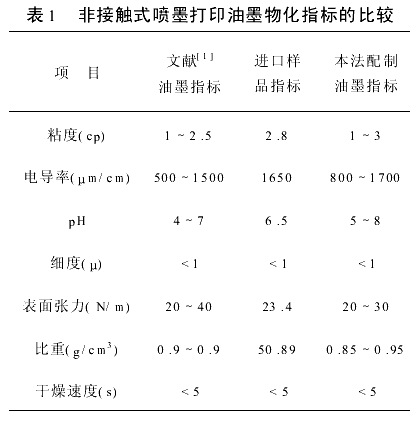Non-contact automatic printing technology uses a printer to print the required marks (such as production date, shelf life, batch number, etc.) on the surface of irregular product packaging in an electronically controlled manner, which can be synchronized with the production line. The technology is widely used in food, beverage, pharmaceutical, chemical and other industries.
Due to the special nature of the technology, it is required that the ink must have a certain electrical conductivity to meet the needs of electronic control; there must be a good adhesion to ensure strong adhesion on the surface of the product packaging; the colorant should be bright and have good weather resistance The printing is smooth and the printing mark is quickly dried. With this level of ink, there is basically no production in the country, mainly relying on imports.
1 Development of ink
1.1 Solvent
In ink-jet printing inks, the solvent serves as a carrier to play a decisive role in the performance of the ink. Solvents are required to quickly dissolve colorants, binders, etc., and to have the right degree of volatility to effectively control the drying speed during inkjet printing. During the test, it was found that the use of two or more low-carbon-number ketones and alcohols as the solvent is best when mixed in a certain proportion, and the addition amount is about 70% to 90% of the total weight of the ink.
1.2 Colorants
Regardless of the type of colorant, it must have sufficient dissolving power in the solvent, and has good mutual solubility with the other components in the ink, bright colors, good weatherability, and good aging resistance. The experiment found that in addition to meeting the above requirements, organic chromium complex pigments also have good electrical conductivity in selected organic solvents and can provide a certain degree of electrical conductivity. The amount of colorant added in the ink accounts for about 3.0% to 8.0% of the weight of the ink in order to achieve the required color depth.
1.3 Adhesives
The binder is the main component of the ink jet printing ink, and its role is mainly as a carrier of the pigment, which enhances the adhesion of the printing mark on the surface of the object. It is required that the binder be completely dissolved in the solvent and has good mutual solubility with other ingredients. After comparing the adhesion of the cellulose-based adhesive to the surface of the object, it is the preferred adhesive, and the amount added is from 5.0% to 10.0% of the total weight of the ink.
1.4 Conductivity regulators
In order to meet the needs of electronic control, the ink requires a certain degree of conductivity, so it is necessary to add conductivity regulators. In addition to the colorant providing a certain conductivity value, the ink also uses an ionizable organic or inorganic salt as a conductivity modifier, for example, tetramethylammonium acetate has better solubility in the selected solvent, and can provide Sufficient conductivity value is added in an amount of 0.5% to 2.0% of the total weight of the ink.
1.5 Other additives
In the ink also need to add some other additives to improve ink performance, for example: adding 1.0% to 5.0% of anti-volatilizer to improve the stability of the ink, enhance the gloss of the printing mark, prevent the inkjet nozzle drying; test selection N-methylpyrrolidone, glycol ethers and phthalates are used as anti-volatilizers. Another silane coupling agent is added to improve the adhesion of the adhesive to the surface of the substrate. The addition of a surfactant to reduce the surface tension increases the performance of the entire ink.
2 ink preparation and application
2.1 Preparation
In the closed equipment, the selected colorant and solvent are mixed and stirred until the colorant is completely dissolved; then the binder, conductivity modifier, anti-volatility agent, coupling agent, and surfactant are separately added, and the mixture is fully stirred until added. Mix evenly. The inks prepared by this method are shown in Table 1 in comparison with the known samples.

2.2 Application
The ink prepared by the above method was applied to the surface of cans, mineral water bottles and beer bottles. The test found that the prepared ink had better adhesion to the above materials, the drying speed met the requirements, and the printing marks were clear. The friction resistance comparison test was performed on the surface of the above three materials with the imported sample. The test method was described in the literature [2]: The ink was printed on the surface of the above three materials, and after drying, the ink was rapidly rubbed with the thumb and observed. The number of times the mark is rubbed off. If the mark can maintain 10 rubs, denoted as 10 (+), the mark is considered permanent. The test results are shown in Table 2.

3 Development prospects
At present, many manufacturers in China use the printer to print the production date, shelf life, batch number, etc. on the surface of the product packaging. Its use has been very extensive, but the required ink depends on imports, and there is basically no production in the country. It is understood that the domestic price of the current ink is about 500 yuan for 1 kg, and the cost is only about 60 yuan, and the profit is higher. Therefore, the development of a variety of substrate surface adhesion, stable performance of the ink, using domestic ink to replace imported ink, must have a broad application prospects.
Source: Print Chemicals Network
Galvanized Sheet Coil,Galvanized Steel Sheet,Galvanized Sheet
Vanfond Import & Export Co., Ltd. , http://www.fastubepipe.com